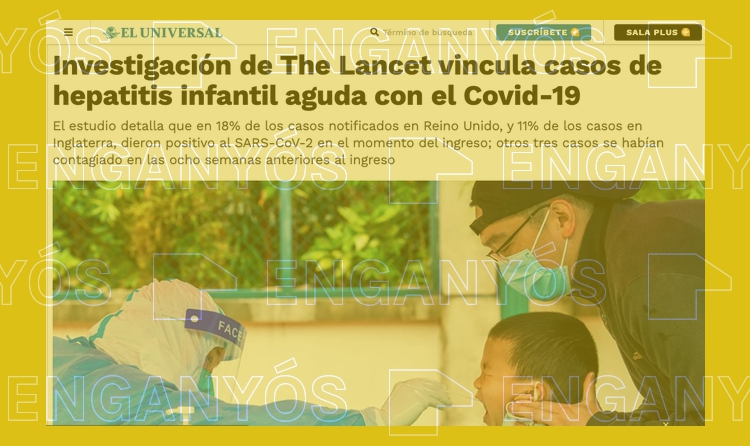The Lancet has not published a study that links the cases of hepatitis in children with covid-19

Why the publications saying that The Lancet linked the cases of hepatitis in children with covid-19 are misleading

A number of websites and international media outlets have published texts claiming that the medical journal The Lancet has published “a study” linking the cases of severe acute hepatitis in children with a covid-19 infection. These articles are MISLEADING. The publication is not a study, but an article in the correspondence section of the journal. In the text, the scientists do not provide any new evidence; rather, they suggest a hypothesis based on existing evidence that hepatitis is the consequence of an adenovirus infection in children who had previously been infected with SARS-CoV-2, the virus that causes covid-19.
The Lancet has published a study that links severe acute hepatitis in children with the coronavirus
In the past several weeks, health authorities in several countries have warned that there is an outbreak of acute hepatitis of unknown origin in children. The United Kingdom’s health department on 5 April reported the phenomenon, which is affecting in particular children between 1 and 4 years of age. The latest hypotheses are indicating that the origin of these cases of hepatitis is an adenovirus, which could be acting alone, in conjunction with another pathogen, or after infection by another disease (such as covid-19). Although the cause is still unknown, the possibility that it is being caused by covid-19 vaccines has been discarded, as we explained recently (Spanish only).
As for the article in question: the hypothesis that these hepatitis cases could be linked to a previous SARS-CoV-2 infection was published by scientists Petter Borden and Moshe Arditi in a joint letter to The Lancet Gastroenterology and Hepatology, a journal published by The Lancet Group. The text does not publish the results of any study, as several websites are claiming. It is, rather, a letter written by two experts in the field who are sharing a hypothesis based on current evidence.
As the Lancet Group explains on their website, the letters or Correspondence articles are “our readers’ reflections on content published in the Lancet journals or on other topics of general interest to our readers”.
The authors “are creating a working hypothesis and suggesting that it should be studied, but it is just one of many hypotheses”, explains Marina Berenguer to Verificat. Berenguer is a professor at the University of Valencia, head of the Hepatology and Hepatic Transplant research group of the Health Research Institute Hospital La Fe, coordinator of the Liver and Digestive Diseases Centre of the Spain’s Network of Biomedical Research Centres (CIBEREHD), and former president of the International Liver Transplant Society (ILTS). “It’s not possible to say that this is what’s happening”, she declares.
A widespread lack of evidence
In their update on 11 May, the European Centre for Disease Prevention and Control reported between 102 and 106 cases of hepatitis in children in European countries (including 22 in Spain), 163 in the United Kingdom and 181 in the rest of the world. However, as we already explained in this article (Spanish only), the cause has still not been identified. In their update on 6 May, the UK Health Security Agency (UKHSA) compiled the main working hypotheses that specialists are investigating all over the world. The institution included the possibility put forward by the authors of the text published in The Lancet: that a normal adenovirus infection, paired with a previous infection (by SARS-CoV-2 or another virus) was the cause of the hepatitis cases. This is one of 10 possible hypotheses they take into account. Others include, for example, a new adenovirus or SARS-CoV-2 variant, a new pathogen or environmental exposure as possible causes.
At this point, knowledge is so lacking that hypotheses even include the possibility that the episode might not be anything out of the ordinary: the update on the public health emergency published on 13 May by Spain’s Ministry of Health states that the total number of “cases observed [within Spain] would be within the expected range, except for in the age group of 1 to 4 years, where a possible excess above the upper limit is being observed”.